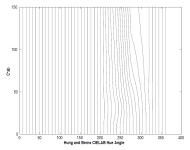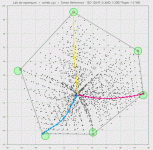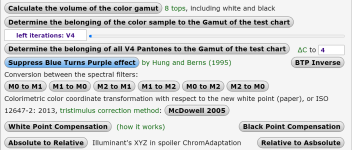mihas
Active member
R.W.G. HUNT writes that the "blue turns purple problem" is embedded in the trichromatic principle itself (and not only is a cost of the CIE Lab), and its degree depends on the nature of the spectral sensitivity curves of sensors and/or spectral reflection (transmission) curves of dyes.
"When a color is reduced in chroma to fit within a destination gamut, following a line of constant metric hue angle (e.g., CIELAB h), the perceived hue of that color will change if the reference color space is non-linear with respect to hue. This
has ben shown for the CIELAB color space (Hung and Berns (1995), Ebner and Fairchild (1998))". (Gustav J. Braun, Mark D. Fairchild, Fritz Ebner: Color Gamut Mapping in a Hue-Linearized CIELAB Color Space).
Present here suppress "blue turns purple problem" in color data.
"When a color is reduced in chroma to fit within a destination gamut, following a line of constant metric hue angle (e.g., CIELAB h), the perceived hue of that color will change if the reference color space is non-linear with respect to hue. This
has ben shown for the CIELAB color space (Hung and Berns (1995), Ebner and Fairchild (1998))". (Gustav J. Braun, Mark D. Fairchild, Fritz Ebner: Color Gamut Mapping in a Hue-Linearized CIELAB Color Space).
Present here suppress "blue turns purple problem" in color data.














